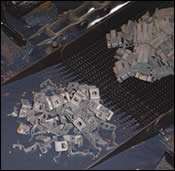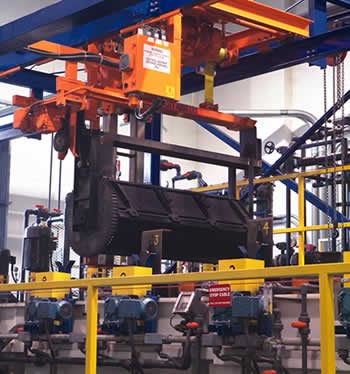Bulk E-Coat Has Arrived
How Do You Finish All those Small Parts?
#pollutioncontrol
Electrocoating has long been recognized as an excellent way to apply a high-quality primer or finish coat on metal parts. It can be applied in a thin and uniform film with penetration into recesses and excellent corrosion resistance. Parts can be hung closely together, and there is no application labor. Material utilization is very high because there is no overspray, and the process generates minimal amounts of VOCs.
Racking parts and hanging the racks from a conveyor system has been the most common way of processing product through an e-coat system, but racking large volumes of parts is labor-intensive and the racks can be expensive. This is especially true when running very small parts such as screws and other fasteners.
Featured Content
Recent advances in e-coat paint formulations and equipment design have made the concept of bulk application of electrocoat a reality. Bulk processing can enable coating of large quantities of parts with a relatively small system, but these systems have been used sparingly due to problems with part-to-part sticking and damage to coated parts before they curing. These handling issues can create visual imperfections and reduce corrosion performance. As a result, bulk e-coat applications have been used mainly for lower- end finishes and specifications.
Now, however, equipment suppliers, paint formulators and applicators are attempting to address the shortcomings of bulk processes. Many applicators modified their part-handling systems. Paint suppliers have developed modified products designed for bulk application. These and other developments in equipment and materials have minimized many of the previous limitations of bulk processes, making high-quality bulk e-coat application possible.
Applicability
Bulk processing can offer a significant improvement in labor and handling, but the resulting finish must be evaluated to ensure it meets customer expectations for appearance and performance.
Appearance specifications should be evaluated first. Many finishes need to be Class A, with no blemishes or imperfections in the paint film. The bulk process may leave some touch marks that will be unacceptable for Class A surfaces.
Bulk e-coat may leave some touch marks on the part from the conveyance or the parts themselves. These marks must be very small and few in number in order to be acceptable. Parts that need to have a continuous finish but may be acceptable with a touch mark on them are good candidates for bulk application.
Parts with complex geometry are also good candidates for bulk application. Complex components are less likely to nest against one another, and they will break up easily after processing.
Fasteners are very good for bulk application. They have no tendency to stick together after processing, and they’re small enough that they generally exhibit very small touch marks after processing. Bulk e-coat will minimize excess fill in the recesses of fastener heads—a common problem with dip-spin coating systems—and coating thickness can be held to a reliable 0.6 to 0.8 mils.
| Table I. Corrosion Resistance of Different Finishes On Fasteners | |||
| Pretreatment | Salt Spray Hours | Cycles of Scab Corrosion | Kesternich Cycles |
| Iron Phosphate | 150–240 | 5–10 | 3–5 |
| Zinc Phosphate | 240–500 | 10–30 | 10–20 |
| Zinc Plate | 240–500 | 10–30 | 10–20 |
| Zinc Alloy Plate | 1,000–1,500 | 40+ | 40+ |
Small, flat parts or parts that have significant weight per square foot are not typically well suited to bulk application. Small parts will tend to nest together while processing and will stick together after they are cured. Heavy parts tend to have more and larger marks on them, both from each other and from the conveyance. Either way these parts will be visually unacceptable to the end user.
Corrosion resistance is the next obstacle to overcome in bulk application of electrocoat. Most finishers use salt spray resistance and cyclical testing to quantify finish performance. Bulk electrocoat can provide a finish that will meet end user specifications for corrosion resistance provided the correct pretreatment process is used.
Zinc phosphate is typically the pretreatment of choice for e-coat in general and bulk application in particular. Some forms of zinc plating and alloy plating can also be used effectively, depending on specifications. Table 1 shows the typical corrosion resistance of different total finishes utilizing bulk electrocoat applied in a barrel application. Data are based on cathodic epoxy e-coat chemistry applied at 0.8 to 1.0 mils film thickness.
Finish durability is critical when parts will be exposed to an outdoor environment. Bulk electrocoat of parts can provide good outdoor performance with acrylic technologies. Chemistry must be evaluated properly to confirm that the finish has good weatherability. Most finishes that require outdoor durability will be tested using QUV test chambers or modified tests. Acrylic technologies applied in a bulk application have passed 500–1,000 hr of QUV testing with little or no loss of gloss and no loss of film integrity.
One additional requirement that may be specified, especially in the fastener industry, is torque tension reliability of the finish, a measure of the lubricity of the cured electrocoat film. It measures how much slip the finish has based on certain clamp loads. It is important that the finish have a consistent amount of slip additive to provide the same torque tension characteristics from lot to lot of processed parts. Torque tension is very important in the automotive industry to ensure that fasteners will assemble consistently and provide a good fit.
Electrocoat chemistry is the key to achieving proper torque tension levels in the electrocoat film. Bulk electrocoat application with chemistry that includes an integrally cured torque tension product has produced consistent results in production applications.
Bulk System Chemistry
Paint formulations for bulk e-coating are not standard technologies. Although the basic chemistries are either epoxy or acrylic, special products have been developed for the bulk process. Both chemistry and the application technique should be discussed with an electrocoat supplier and an equipment vendor before a bulk system is specified or installed.
Epoxy chemistry has been the easiest to adapt to bulk electrocoat application. Suppliers modified epoxy resin systems to improve film uniformity and minimize touch marks in bulk applications. The epoxy chemistries also provide good results in all testing versus a standard epoxy applied in a rack e-coat system. The application method, in conjunction with the proper epoxy chemistry, can supply a finish that will meet many OEM finish requirements.
Acrylic technology has been more difficult to adapt to bulk applications. The resin systems used for acrylic finishes produce a film that is inherently sticky when wet, which exaggerates the tendency toward part-to-part sticking during the cure process. Recent developments in acrylic resin systems have minimized sticking and allowed parts to release after curing. As long as the e-coat film is continuous with only minor touch marks, an acrylic electrocoat finish will provide performance comparable to that of rack-processed parts.
Pigments for both epoxy and acrylic systems must be compatible with the bulk electrocoat resin systems. They are developed to maximize part coverage while minimizing the tendency for the parts to stick together or to the equipment moving the parts through the process.
Additives incorporated into the pigment or the resin help coalesce the film in the bulk e-coat system. The additives must be present in the electrocoat bath in the proper concentration so that the film will not be rough or susceptible to rupture.
Ideally, bulk e-coat paint chemistries result in parts with the same performance characteristics as parts processed using traditional application methods. It is important that the paint supplier work in conjunction with the equipment supplier and the applicator to make sure equipment, paint and the application work well in a specific production situation.
Table II compares the characteristics of three types of e-coat paint chemistries.
| Table II. Paint Characteristics for Bulk Electrocoat | |||
| Cathodic Epoxy | Cathodic Acrylic | Anodic Epoxy | |
| Bulk Application | Yes | Yes | Yes |
| Corrosion Resistance | Good to Excellent | Fair | Fair |
| Durability | Fair | Good | Fair |
| Gloss | Semi gloss to glossy | Semi gloss to glossy | Low gloss |
| Color Availability | Wide palette | Limited palette | Limited palette |
| Edge Coverage | Good | Fair to poor | Fair |
| Heavy Metal Free | Yes | Yes | Yes |
| Film Builds | 0.5–1.0 mils | 0.5–1.0 mils | 0.2–0.6 mils |
| VOC | Low | Low | Medium |
Bulk Equipment
Most bulk e-coating lines have been barrel or basket applications. These systems have sometimes not produced the quality of finish that was needed in the industrial market, but recent advances have made the barrel a more reliable conveyance for the bulk electrocoating of parts.
The barrel process is able to produce parts in high volume with only minor touch marks and virtually no part-to-part sticking. These factors have allowed parts processed in a barrel to meet many specifications and paved the way for new fastener specifications that include cathodic electrocoat processed in bulk.
Rotation of parts in the barrel must be controlled to produce the proper finish and minimize damage to parts during coating. Rotation in excess of 2 rpm can cause severe damage to parts; rotation should be as slow as possible to reorient parts with minimal damage.
Load size is also critical to e-coating of small parts in a barrel. Loads should be large enough to permit efficient processing of the parts but not so large that they cause damage to the parts. Each part must be evaluated to determine the best load size that optimizes quality and efficient throughput.
Rinsing is also critical to barrel e-coat. It is important to have at least four rinses after paint application to ensure that any drag-out of electrocoat material is fully removed from parts. Any residual electrocoat left on the parts could cause sticking in the curing operation.
Barrel application processes using returnable-programmed hoists and a slide rail square transfer system fitted with barrels have been successfully used for bulk e-coat. Both systems have been commercialized for many years and have been used with cathodic electrocoat chemistries.
Typically used where the electrocoating process is separate from the pretreatment system, programmable hoists are a good choice when the applicator already has the pretreatment system in place or when the applicator plans on applying other coatings in addition to the electrocoat system. This system processes parts through the e-coat system and returns them to a location where they are transferred for curing. A vibratory table is often used to feed the parts uniformly onto a belt oven. In some cases the parts are put on trays and transferred to a batch oven.
Slide rail square transfer systems typically have the pretreatment and electrocoat process in line. Parts are loaded at the beginning of the process, then transferred from stage to stage through pretreatment, electrocoat and the curing cycle. This provides an efficient processing method for applicators with smaller part volumes.
Slide rail square transfer systems can also process parts in baskets or on racks. Parts are cured in the barrel or the basket. Typically the parts are rotated slightly in the barrel during the curing process to reorient parts to minimize part-to-part sticking.
In another type of bulk e-coat system, parts ride through processing on a continuous metal belt. The conveyor surface is designed to minimize touch marks and allow dense part loading, while an agitation system reduces gas bubbles. Special paint chemistry is a requirement for this type of system.
RELATED CONTENT
-
The Hull Cell: Key to Better Electroplating - Part II
How to use it for planning, preventive maintenance and troubleshooting.
-
Preparation for Electroplating
What you should know about cleaning and electrocleaning.
-
Conversion Coatings: Phosphate vs. Zirconium
Both phosphate-based and zirconium coatings have their advantages, but zirconium is fast becoming the pretreatment of choice.






















